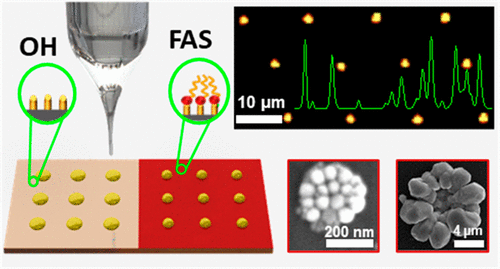Our official English website, www.x-mol.net, welcomes your
feedback! (Note: you will need to create a separate account there.)
Chemical Funneling of Colloidal Gold Nanoparticles on Printed Arrays of End-Grafted Polymers for Plasmonic Applications.
ACS Nano ( IF 15.8 ) Pub Date : 2020-06-22 , DOI: 10.1021/acsnano.0c01987 Sami Pekdemir 1, 2 , Ilker Torun 1, 2 , Menekse Sakir 1, 2 , Mahmut Ruzi 2 , John A Rogers 3, 4 , M Serdar Onses 1, 2, 5
ACS Nano ( IF 15.8 ) Pub Date : 2020-06-22 , DOI: 10.1021/acsnano.0c01987 Sami Pekdemir 1, 2 , Ilker Torun 1, 2 , Menekse Sakir 1, 2 , Mahmut Ruzi 2 , John A Rogers 3, 4 , M Serdar Onses 1, 2, 5
Affiliation

|
Spatially defined assembly of colloidal metallic nanoparticles is necessary for fabrication of plasmonic devices. In this study, we demonstrate high-resolution additive jet printing of end-functional polymers to serve as templates for directed self-assembly of nanoparticles into architectures with substantial plasmonic activity. The intriguing aspect of this work is the ability to form patterns of end-grafted poly(ethylene glycol) through printing on a hydrophobic layer that consists of fluoroalkylsilanes. The simultaneous dewetting of the underlying hydrophobic layer together with grafting of the printed polymer during thermal annealing enables fabrication of spatially defined binding sites for assembly of nanoparticles. The employment of electrohydrodynamic jet printing and aqueous inks together with reduction of the feature size during thermal annealing are critically important in achieving high chemical contrast patterns as small as ∼250 nm. Gold nanospheres of varying diameters selectively bind and assemble into nanostructures with reduced interparticle distances on the hydrophilic patterns of poly(ethylene glycol) surrounded with a hydrophobic background. The resulting plasmonic arrays exhibit intense and pattern-specific signals in surface-enhanced Raman scattering (SERS) spectroscopy. The localized seed-mediated growth of metallic nanostructures over the patterned gold nanospheres presents further routes for expanding the composition of the plasmonic arrays. A representative application in SERS-based surface encoding is demonstrated through large-area patterning of plasmonic structures and multiplex deposition of taggant molecules, all enabled by printing.
中文翻译:

胶体金纳米颗粒在等离子应用的最终接枝聚合物印刷阵列上的化学漏斗。
胶体金属纳米粒子的空间定义组装对于制造等离激元器件是必需的。在这项研究中,我们演示了最终功能聚合物的高分辨率加成喷射印刷,以用作模板,将纳米粒子定向自组装成具有实质性等离子体活性的结构。这项工作的有趣之处在于能够通过在由氟代烷基硅烷组成的疏水层上印刷形成末端接枝的聚乙二醇图案。在热退火过程中,底层疏水层的同时脱湿以及印刷聚合物的接枝使得能够制造用于组装纳米粒子的空间限定的结合位点。在获得低至约250 nm的高化学对比图案时,采用电液喷射印刷和水性油墨以及减小热退火过程中的特征尺寸至关重要。直径可变的金纳米球选择性地结合并组装成纳米结构,其在被疏水背景包围的聚乙二醇的亲水图案上具有减小的粒子间距离。所得的等离激元阵列在表面增强拉曼散射(SERS)光谱中显示出强烈且特定于模式的信号。在图案化的金纳米球上金属纳米结构的局部种子介导生长为扩展等离子体阵列的组成提供了进一步的途径。
更新日期:2020-07-28
中文翻译:

胶体金纳米颗粒在等离子应用的最终接枝聚合物印刷阵列上的化学漏斗。
胶体金属纳米粒子的空间定义组装对于制造等离激元器件是必需的。在这项研究中,我们演示了最终功能聚合物的高分辨率加成喷射印刷,以用作模板,将纳米粒子定向自组装成具有实质性等离子体活性的结构。这项工作的有趣之处在于能够通过在由氟代烷基硅烷组成的疏水层上印刷形成末端接枝的聚乙二醇图案。在热退火过程中,底层疏水层的同时脱湿以及印刷聚合物的接枝使得能够制造用于组装纳米粒子的空间限定的结合位点。在获得低至约250 nm的高化学对比图案时,采用电液喷射印刷和水性油墨以及减小热退火过程中的特征尺寸至关重要。直径可变的金纳米球选择性地结合并组装成纳米结构,其在被疏水背景包围的聚乙二醇的亲水图案上具有减小的粒子间距离。所得的等离激元阵列在表面增强拉曼散射(SERS)光谱中显示出强烈且特定于模式的信号。在图案化的金纳米球上金属纳米结构的局部种子介导生长为扩展等离子体阵列的组成提供了进一步的途径。











































 京公网安备 11010802027423号
京公网安备 11010802027423号